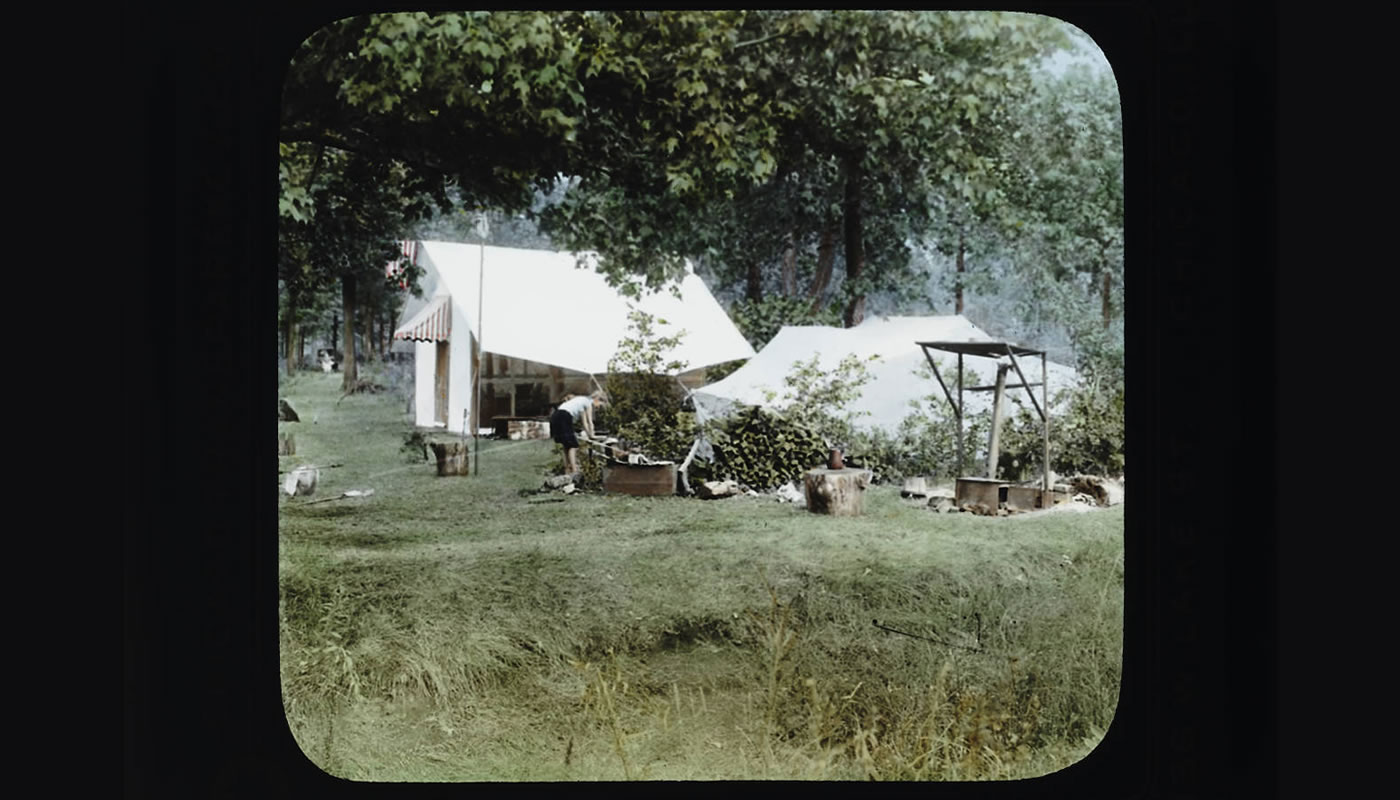In the Forest Preserve District of Cook County’s first decades, the preserves became a place where people supplemented their incomes and lived off the land. In the wintertime, they cut ice from ponds and purchased cheap firewood chopped from fallen trees. In the summertime, people harvested vegetables from gardens and even resided in the forest preserves. Officials increasingly realized that this intensive use damaged the natural resources they were mandated to protect. So by the late 1930s, they began curtailing long-term and extractive activities on forest preserve land.
Families facing hardship appear to have sought temporary shelter in the forest preserves—sometimes by invitation. In 1922, The Chicago Defender reported that thousands of Chicagoans “saved rent” over the summer by living in “tent colonies” located in the forest preserves.[i] In 1921, the District described these dwellings in romantic terms, writing, “there is a growing tendency on the part of many families to pitch week-end camps, while others remain during longer periods, some passing the entire summer under the shade of the great woods.”[ii] In 1920, District commissioners unanimously adopted a resolution to provide housing in the preserves for people affected by “a devastating tornado” that had swept through western and northwestern Cook County.[iii]
During the Great Depression, the District’s administrators worked with Illinois’s Joint Emergency Relief Fund to permit people to grow food on forest preserve land. In the early 1930s, a group of men farmed a tract at 113th Street and Keane Road, where they harvested corn, beans, and other vegetables.[iv] In 1932, a representative from the Calumet City Relief Organization wrote Charles Sauers (who served as General Superintendent from 1929 to 1964) and asked him to again permit unemployed men from the southern suburbs to cultivate “truck gardens” in the forest preserves. The representative told Sauers, “The results obtained this year were very satisfactory and in many instances the surplus vegetables have been canned.”[v] Even an executive from the International Harvester Company—a farm equipment manufacturer—asked the District to allow the company’s laid-off workers to use forest preserve land to grow food for themselves. At the intersection of Cumberland Avenue and Irving Park Road, former Harvester employees cultivated 800 gardens in 1932.[vi]
Beginning in the late 1930s, the District gradually changed its policies to lessen the public’s dependence on the forest preserves. Sauers believed the earliest leaders had encouraged people to do things like dwell and garden on the land, because they were “anxious that the public begin to use them and to realize the value of the holdings.” Eventually, their plan backfired, and the natural resources in the forest preserves started to visibly deteriorate. Sauers in part blamed the decline on improved access. He wrote, “With the rapid increase in the ownership of automobiles and the construction of better roads, the district soon found itself in the predicament of having more business than it could handle.”[vii] In wake of that predicament, Sauers and his administrative team directed the public to reduce their impact, and encouraged Cook County residents to use the forest preserves for daylong recreation and experiential learning—as visitors still do today.
The Centennial History Series takes an in-depth look at various chapters throughout the Forest Preserves’ 100 years. Natalie Bump Vena is a JD/PhD candidate in Northwestern University’s School of Law and Department of Anthropology. She is also the Gaius Charles Bolin Fellow in Anthropology and Environmental Studies at Williams College in Williamstown, MA. Natalie is writing her dissertation about the history of natural resources policy in the Forest Preserve District of Cook County. She grew up on Chicago’s South Side and visited the Palos forest preserves most weekends with her family.
- [i] “Rents too high; live in tents,” The Chicago Defender, April 29, 1922.
- [ii] Forest Preserve District of Cook County, Annual Report of 1921.
- [iii] Resolution by Peter Reinberg. Proceedings of the Forest Preserve District Board of Commissioners, 1930. March 29, 1930 (p. 103-104).
- [iv] Letter from Harry C. Leemon to Charles Sauers, October 25, 1932. Forest Preserve District of Cook County Collection, Special Collections, University of Illinois at Chicago. Series I, Box 17, Folder 167.
- [v] Letter from John Jaranowski to Charles Sauers, October 11, 1932. Forest Preserve District of Cook County Collection, Special Collections, University of Illinois at Chicago. Series I, Box 17, Folder 167.
- [vi] Letter from George Kellogg (of the International Harvester Company) to Emmett Whealan, August 26, 1932. Forest Preserve District of Cook County Collection, Special Collections, University of Illinois at Chicago. Series I, Box 17, Folder 167.
- [vii] Charles Sauers, “Brief History of the Origin and Development of the Forest Preserve District of Cook County, Illinois, Part II.” The Forest Way. Ca. Spring 1945. Forest Preserve District of Cook County Collection, Special Collections, University of Illinois at Chicago. Series I, Box 47, Folder 523.

